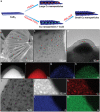Stable Cu Catalysts Supported by Two-dimensional SiO2 with Strong Metal-Support Interaction
- PMID: 35075801
- PMCID: PMC8948561
- DOI: 10.1002/advs.202104972
Stable Cu Catalysts Supported by Two-dimensional SiO2 with Strong Metal-Support Interaction
Abstract
Cu-based catalysts exhibit excellent performance in hydrogenation reactions. However, the poor stability of Cu catalysts under high temperatures has restricted their practical applications. The preparation of stable Cu catalysts supported by SiO2 with strong metal-support interaction (SMSI) has thus aroused great interest due to the high abundance, low toxicity, feasible processability, and low cost of SiO2 . The challenge in the construction of such SMSI remains to be the inertness of SiO2 . Herein, a simple and scalable method is developed to prepare 2D silica (2DSiO2 ) supported Cu catalysts with SMSI by carefully manipulating the topological exfoliation of CaSi2 with CuCl2 and thereafter calcination. The prepared Cu-2DSiO2 catalysts with the unique encapsulated Cu nanoparticles exhibit excellent activity and long-term stability in high-temperature CO2 hydrogenation reactions. This feasible and low-cost solution for stabilizing Cu catalysts might shed light on their realistic applications.
Keywords: Cu/SiO2; high-temperature stability; strong metal-support interaction (SMSI)FF.
© 2022 The Authors. Advanced Science published by Wiley-VCH GmbH.
Conflict of interest statement
The authors declare no conflict of interest.
Figures




References
-
- Kattel S., Ramírez Pedro J., Chen Jingguang G., Rodriguez José A., Liu P., Science 2017, 355, 1296. - PubMed
-
- Gawande M. B., Goswami A., Felpin F.‐X., Asefa T., Huang X., Silva R., Zou X., Zboril R., Varma R. S., Chem. Rev. 2016, 116, 3722. - PubMed
-
- An B., Li Z., Song Y., Zhang J., Zeng L., Wang C., Lin W., Nat. Catal. 2019, 2, 709.
-
- Beck A., Zabilskiy M., Newton M. A., Safonova O., Willinger M. G., van Bokhoven J. A., Nat. Catal. 2021, 4, 488.
-
- Yue H., Zhao Y., Zhao S., Wang B., Ma X., Gong J., Nat. Commun. 2013, 4, 2339. - PubMed
Grants and funding
- 2021YFF0502000/National Key R&D Program of China
- 51902287/National Natural Science Foundation of China
- Jiangsu Key Laboratory for Carbon Based Functional Materials & Devices
- KJS2018/Soochow University
- FZ2020020/State Key Laboratory of New Textile Materials and Advanced Processing Technologies
- 61721005/The Foundation for Innovative Research Groups of the National Natural Science Foundation of China
- Government of Canada
- Materials Chemistry and Nanochemistry
- Ontario Ministry of Research Innovation
- Ministry of Economic Development
- Employment and Infrastructure
- Ministry of the Environment and Climate Change
- Ministry of Research
- Innovation and Science
- Low Carbon Innovation Fund
- Connaught Global Challenge Fund
- Natural Sciences and Engineering Research Council of Canada
- Beijing Synchrotron Radiation Facility
LinkOut - more resources
Full Text Sources
Other Literature Sources
